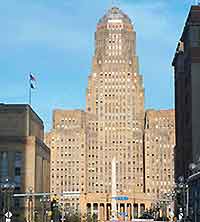Buffalo History Facts and Timeline
(Buffalo, New York - NY, USA)

New York's second city, the 'City with a Heart', grew fast and is most noted for its steel plants and grain industries.
First home to Indian tribes, as with most other regional centers, Buffalo and its history emerged in the 1830s, with the city being known today for its ethnic enclaves and monumental buildings. It has won many accolades for its cleanliness and livability.
Early Buffalo History
Prior to the French, who arrived at Buffalo Creek in the 1750s, the Neutral Nation and then the Ongiara Iroquois Indians were the first on the scene. The British took control of the region and built the town on a radial street system, as opposed to the standard grid of today. During the War of 1812, the British burnt the town on retreat.
The building of the Erie Canal in 1828 saw much growth to the area and eventually led to the founding of Buffalo as a city in 1832. Its wealthiest citizen, Dr. Ebenezer Johnson, was appointed mayor, and this was, ironically, hastily followed by a serious cholera outbreak.
Good Times
Buffalo grew fast, mainly through grain and brewing industries, and new canals were built along with an extension of the harbor. Railway lines were added, including the historic Buffalo to
Niagara Falls route, while the Commercial Bank opened its doors in 1834. Meanwhile, architect Benjamin Rathbun threw up many noted buildings, including the City Jail, Darrow Block and the American Hotel. St. Paul's Episcopal Cathedral went up in the mid-19th century.
Canal Street duly became the 'wickedest street in the world', with its saloons, bars and brothels. To see abodes of this time, head to the north of downtown and into the Buffalo Allentown Historic District, an area of red-brick houses in the French Second Empire and Italianate styles. The Allendale Theater and Tiffts Row houses are among the best examples. For the big mansions of the day, head to the Delaware Avenue Historic District, otherwise known as 'Millionaire's Row'.
20th-Century Buffalo
Immigrants, in particular Irish, Italian, German and Polish new arrivals, were attracted by the expanding economy. Many black Americans were also drawn here as well as to neighboring Ontario. Electric lighting came on the scene early, courtesy of power from the nearby Niagara Falls hydroelectric plants. The new century was looking good, although President William McKinley was assassinated in 1901 at the Pan-American Exposition, held in Buffalo.
Frank Lloyd Wright had a hand in developing Buffalo in the early 1900s, designing many structures, including the Prairie-style Darwin D. Martin House on Summit Avenue. Built in 1931, the City Hall is the standout place in town, featuring an observation deck at 28 floors high, which affords fine views over the city and Lake Erie.
In history, the city declined somewhat from the mid-1900s, owing mainly to the introduction of the St. Lawrence Seaway, which negated the need for ships to go through Buffalo. People also started to move out into the suburbs and industries relocated elsewhere.
Modern Buffalo
Buffalo has revitalized itself despite its declining industry and is today a hub of economy and culture in Western New York. There are more than 250,000 residents, with the city boasting a low cost of living, particularly when compared with
New York City.
There are many museums depicting local history, the most useful of which is the Buffalo and Erie County Historical Society Museum. The Theodore Roosevelt National Historic Site on Delaware Avenue, in the Aynsley Wilcox House, is also revealing.
 New York's second city, the 'City with a Heart', grew fast and is most noted for its steel plants and grain industries.
New York's second city, the 'City with a Heart', grew fast and is most noted for its steel plants and grain industries.